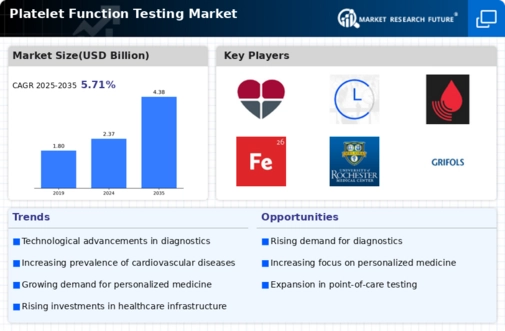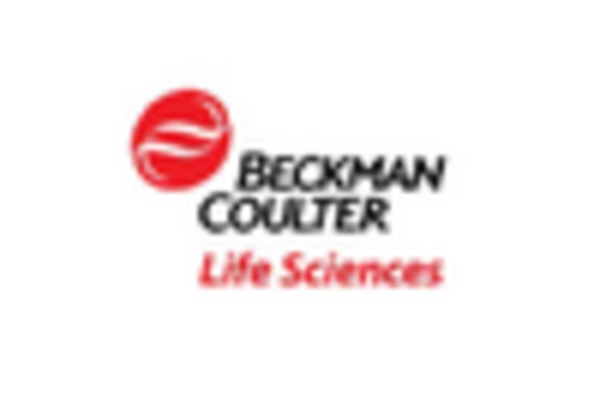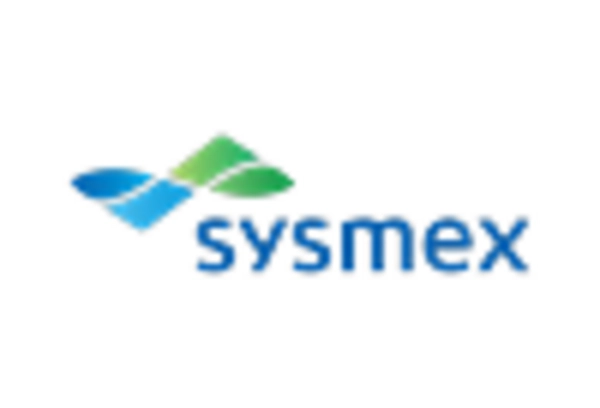Increasing Geriatric Population
The rising geriatric population is a significant factor driving the Platelet Function Testing Market. Older adults are more susceptible to various health conditions, including cardiovascular diseases and thrombotic disorders, which necessitate regular monitoring of platelet function. As the global population aged 65 and above continues to grow, the demand for effective diagnostic tools to assess platelet activity is likely to increase. This demographic shift is prompting healthcare providers to invest in advanced testing solutions to manage the health of elderly patients effectively. Consequently, the Platelet Function Testing Market is expected to experience substantial growth as it adapts to the needs of an aging population.
Growing Awareness of Personalized Medicine
The shift towards personalized medicine is significantly influencing the Platelet Function Testing Market. As healthcare evolves, there is a growing recognition of the need for tailored treatment approaches based on individual patient profiles. Platelet function tests provide critical insights into a patient's hemostatic function, enabling clinicians to customize antiplatelet therapy effectively. This trend is underscored by the increasing number of studies advocating for personalized treatment regimens, which have shown improved patient outcomes. The Platelet Function Testing Market is likely to expand as healthcare providers seek to implement more precise and individualized treatment plans, thereby enhancing the overall quality of care.
Rising Incidence of Cardiovascular Diseases
The increasing prevalence of cardiovascular diseases is a primary driver for the Platelet Function Testing Market. As cardiovascular conditions remain a leading cause of mortality, the demand for effective diagnostic tools has surged. According to recent statistics, cardiovascular diseases account for approximately 31% of all global deaths. This alarming trend necessitates the implementation of advanced testing methods to assess platelet function, which plays a crucial role in thrombus formation and cardiovascular events. Consequently, healthcare providers are increasingly adopting platelet function tests to enhance patient management and treatment strategies. The Platelet Function Testing Market is thus poised for growth as healthcare systems prioritize early detection and intervention in cardiovascular health.
Technological Innovations in Testing Methods
Technological advancements in platelet function testing methodologies are propelling the Platelet Function Testing Market forward. Innovations such as point-of-care testing devices and automated analyzers have improved the accuracy and efficiency of platelet function assessments. These advancements facilitate rapid results, allowing for timely clinical decision-making. The market has witnessed a notable increase in the adoption of these technologies, with a projected growth rate of around 8% annually over the next five years. As healthcare facilities strive to enhance diagnostic capabilities, the Platelet Function Testing Market is expected to benefit from these technological improvements, ultimately leading to better patient management.
Regulatory Support for Diagnostic Innovations
Regulatory bodies are increasingly supporting innovations in diagnostic testing, which is positively impacting the Platelet Function Testing Market. Initiatives aimed at streamlining the approval process for new testing technologies are encouraging manufacturers to develop advanced platelet function assays. This regulatory environment fosters innovation and enhances the availability of cutting-edge diagnostic tools. As a result, healthcare providers are more inclined to adopt these new technologies, leading to improved patient outcomes. The Platelet Function Testing Market is likely to thrive as regulatory support continues to promote the development and implementation of innovative testing solutions.

















Leave a Comment